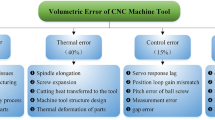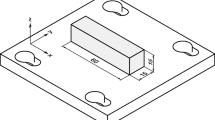Abstract
Load behavior is one of the most critical factors affecting mills’ energy consumption and grinding efficiency, and is greatly affected by the liner profiles. Generally, as liner profiles vary, the ball mill performances are extremely different. In order to study the performance of the ball mill with regular polygon angle-spiral liners(RPASLs), experimental and numerical studies on three types of RPASLs, including regular quadrilateral, pentagonal and hexagonal, are carried out. For the fine product of desired size, two critical parameters are analyzed: the energy input to the mill per unit mass of the fine product, \(E^{*}\), and the rate of production of the fine product, \(F^{*}\). Results show that the optimal structure of RPASLs is Quadrilateral ASL with an assembled angle of 50\({^{\circ }}\). Under this condition, the specific energy consumption \(E^{*}\) has the minimum value of 303 J per fine product and the production rate \(F^{*}\) has the maximum value of 0.323. The production rate \(F^{*}\) in the experimental result is consistent with the specific collision energy intensity to total collision energy intensity ratio \(E_\mathrm{s}/E_\mathrm{t}\) in the simulation. The relations between the production rate \(F^{*}\) and the specific energy consumption \(E^{*}\) with collision energy intensity \(E_\mathrm{s}\) and \(E_\mathrm{t }\) are obtained. The simulation result reveals the essential reason for the experimental phenomenon and correlates the mill performance parameter to the collision energy between balls, which could guide the practical application for Quadrilateral ASL.














Similar content being viewed by others
References
TOUIL D, BELAADI S, FRANCES C. The specific selection function effect on clinker grinding efficiency in a dry batch ball mill[J]. International Journal of Mineral Processing, 2008, 87(3–4): 141–145.
GUPTA V K, SHARMA S. Analysis of ball mill grinding operation using mill power specific kinetic parameters[J]. Advanced Powder Technology, 2014, 25(2): 625–634.
LIU S J, HU J H, ZHANG R Q, et al. Development of mining technology and equipment for seafloor massive sulfide deposits[J]. Chinese Journal of Mechanical Engineering, 2016, 29(6): 863–870.
WU X F, FENG G C, LIU X L. Design and implementation of a system for laser assisted milling of advanced materials[J]. Chinese Journal of Mechanical Engineering, 2016, 29(6): 921–929.
BENZER H, E RGUN L, ONER M, et al. Simulation of open circuit clinker grinding[J]. Minerals Engineering, 2001, 14(7): 701–710.
MAKOKHA A B, MOYS M H, BWALYA M M, et al. A new approach to optimizing the life and performance of worn liners in ball mills: Experimental study and DEM simulation[J]. International Journal of Mineral Processing, 2007, 84(1–4): 221–227.
MALEKI-MOGHADDAM M, YAHYAEI M, BANISI S. A method to predict shape and trajectory of charge in industrial mills[J]. Minerals Engineering, 2013, 46–47(6): 157–166.
KALALA J T, BREETZKE M, MOYS M H. Study of the influence of liner wear on the load behaviour of an industrial dry tumbling mill using the Discrete Element Method(DEM)[J]. International Journal of Mineral Processing, 2008, 86(86): 33–39.
POWELL M S, WEERASEKARA N S, COLE S, et al. DEM modeling of liner evolution and its influence on grinding rate in ball mills[J]. Minerals Engineering, 2011, 24(3–4): 341–351.
CLEARY P W. Charge behavior and Power consumption in ball mills: sensitivity to mill operating conditions, liner geometry and charge composition[J]. International Journal of Mineral Processing, 2001, 63(2): 79–114.
HLUNGWANI O, RIKHOTSO J, DONG H, et al. Further validation of DEM modeling of milling: effects of liner profile and mill speed[J]. Minerals Engineering, 2003, 16(10): 993–998.
CLEARY P W, OWEN P. Effect of liner design on performance of a HICOM\(\textregistered \) mill over the predicted liner life cycle[J]. Minerals Engineering, 2015, 134(11): 11–22.
REZAEIZADEH M, FOOLADI, M, POWELL M S, et al. Experimental observations of lifter parameters and mill operation on power draw and liner impact loading[J]. Minerals Engineering, 2010, 23(15): 1182–1191.
LIANG M, SUN Y, JI P P, et al. Numerical analysis on regular polygon angle-spiral liners design in a ball mill[J]. Journal of Mechanical Engineering, 2015, 51(17): 203–212. (in Chinese)
BOGDANOV V S, KHAKHALEV P A, BOGDANOV N E, et al. The application of EDEM software for design parameters calculation of a ball mill lining[J]. Research Journal of Applied Sciences, 2014, 9 (11): 869–873.
FRANKE J, CLEARY P W, SINNOTT M D. How to account for operating condition variability when predicting liner operating life with DEM-A case study[J]. Minerals Engineering, 2015, 73(3): 53–68.
HERBST J A. A micro scale look at tumbling mill scale–up using high fidelity simulation[J]. International Journal of Mineral Processing, 2004, 74(7): S299–S306.
JOHNNY T, KALALA M B, MOYS M H. Study of the influence of liner wear on the load behavior of an industrial dry tumbling mill using the Discrete Element Method(DEM)[J]. International Journal of Mineral Processing, 2008, 86(1–4): 33–39.
GABRIEL K P, BARRIOS R M, LUIS M T. Modeling breakage of mono-dispersed particles in unconfined beds[J]. Minerals Engineering, 2011, 24(3–4): 308–318.
WANG M H, YANG R Y, YU A B. DEM investigation of energy distribution and particle breakage in tumbling ball mills[J]. Powder Technology, 2012, 223(6): 83–91.
DJORDJEVIC N, SHI F N, MORRISON R. Determination of lifter design, speed and filling effects in AG mills by 3D DEM[J]. Minerals Engineering, 2004, 17(11): 1135–1142.
SEYFI E A, LEVENT E S. The effect of ball size on breakage rate parameter in a pilot scale ball mill[J]. Minerals Engineering, 2009, 22(7–8): 660–664.
ROSENKRANZ S, BREITUNG-FAES S, KWADE A. Experimental investigations and modeling of the ball motion in planetary ball mills[J]. Powder Technology, 2011, 212(1): 224–230.
CLEARY P W, HOYER D. Centrifugal mill charge motion and power draw: comparison of DEM predictions with experiment[J]. International Journal of Mineral Processing, 2000, 59 (2): 131–148.
GAI G S, TAO Z D, DENG M. Powder technology[M]. Beijing: Tsinghua University Press, 2009.(in Chinese)
DENIZ V, ONUR T. Investigation of the breakage kinetics of Pumice sample as depend on Powder filling in a ball mill[J]. Mineral Processing, 2002, 67(1–4): 71–78.
MUNN T JN, MORRELL S, Morrison R D, et al. Mineral comminution circuits: their operation and optimisation[J]. Minerals Engineering, 1996, 10(3): 1–8.
JI P P. Research in effect of ball mill angular-spiral lining configuration on grinding effect[D]. Hangzhou: Zhejiang University of Technology, 2013. (in Chinese)
HAO W J. Numerical analysis on effect of media-to-material ratio on working performance of ball mill[J]. Mining & Processing Equipment, 2010, 38(23): 72–75.(in Chinese)
BALLANTYNE G R, PEUKERT W, POWELL M S. Size specific energy(SSE)-Energy required to generate minus 75 micron material[J]. International Journal of Mineral Processing, 2015, 136(3): 2–6.
GUPTA V K, SHARMA S. Analysis of ball mill grinding operation using mill power specific kinetic parameters[J]. Advanced Powder Technology, 2014, 25 (2): 625–634.
WANG G Q, HAO G J, WANG J X. Discrete element method and its practice in EDEM[M]. Xi’an: Northwestern Polytechnical University Press, 2010. (in Chinese)
POWELL M S, MORRISON R D. A new look at breakage testing[C]//11th European Symposium on Comminution, Budapest, Hungary, October 9–12, 2006: 1–6.
YAHYAEI M, BANISI S. Spreadsheet–based modeling of liner wear impact on charge motion in tumbling mills[J]. Minerals Engineering, 2010, 23(15): 1213–1219.
MULENGA F K, MOYS M H. Effects of slurry filling and mill speed on the net power draw of a tumbling ball mill[J]. Minerals Engineering, 2014, 56(2): 45–56.
VOGEL L, PEUKERT W. Breakage behavior of different materials- construction of a master curve for the breakage probability[J]. Powder Technology, 2003, 129(1–3): 101–110.
GENC O, BENZER A H, ERGUN T. Analysis of single particle impact breakage characteristics of raw and HPGR-crushed cement clinkers by drop weight testing[J]. Powder Technology, 2014, 259(6): 37–45.
YING N. Research on charge collision energy and grinding performance of flutter ball mill[D]. Hangzhou: Zhejiang University of Technology, 2012. (in Chinese)
Author information
Authors and Affiliations
Corresponding author
Additional information
Supported by National Natural Science Foundation of China (Grant Nos. 51675484, 51275474, 51505424), and Zhejiang Provincial Natural Science Foundation of China(Grant Nos. LZ12E05002, LY15E050019).
Rights and permissions
About this article
Cite this article
SUN, Y., LIANG, M., JIN, X. et al. Experimental and Modeling Study of the Regular Polygon Angle-spiral Liner in Ball Mills. Chin. J. Mech. Eng. 30, 363–372 (2017). https://doi.org/10.1007/s10033-017-0044-1
Received:
Revised:
Accepted:
Published:
Issue Date:
DOI: https://doi.org/10.1007/s10033-017-0044-1




